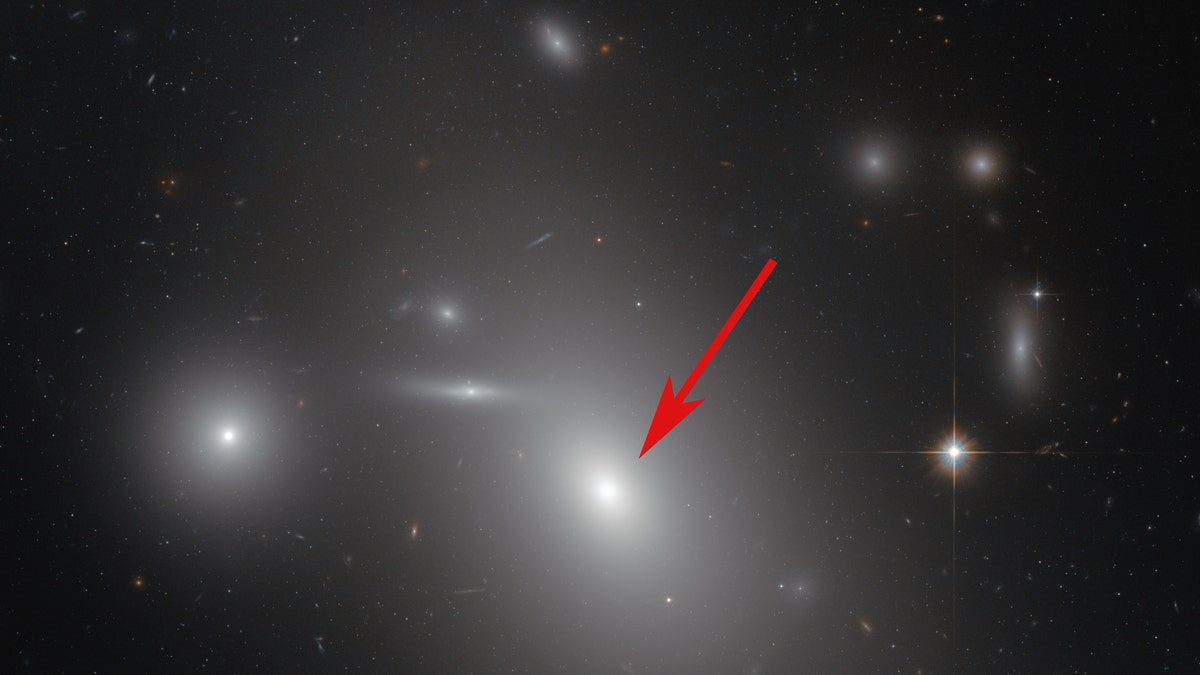
This image taken by the Hubble Space Telescope shows the elliptical galaxy NGC 4889 (arrowed) in front of hundreds of background galaxies. Well-hidden from human eyes, there is a gigantic supermassive black hole at the centre of the galaxy. (Credit: NASA & ESA)
Astronomers have found one of the largest-ever black holes in giant galaxy NGC 4889, some 300 million light years away.
The Hubble space telescope has captured an incredible image of elliptical galaxy NGC 4889, which is located in the Coma Cluster. Scientists, however, note that the giant galaxy harbors a dark secret.
Related: The best of Hubble
The European Space Agency explains that the galaxy contains a supermassive black hole that has 21 billion times the mass of the Sun and an event horizon — the surface at which even light cannot escape its gravitational grasp — of approximately 81 billion miles. That makes the event horizon about 15 times the diameter of Neptune’s orbit from the Sun.
However, the black hole’s time of swallowing stars and devouring dust is past. “Astronomers believe that the gigantic black hole has stopped feeding, and is currently resting after feasting on NGC 4889’s cosmic cuisine,” explained the ESA, in a statement on its website. “The environment within the galaxy is now so peaceful that stars are forming from its remaining gas and orbiting undisturbed around the black hole.”
Related: Hubble space telescope captures stunning image of barred spiral galaxy
Scientists explain that, when it was active, NGC 4889’s supermassive black hole was fuelled by a process known as hot accretion. “When galactic material — such as gas, dust and other debris — slowly fell inwards towards the black hole, it accumulated and formed an accretion disc,” they said. “Orbiting the black hole, this spinning disc of material was accelerated by the black hole’s immense gravitational pull and heated to millions of degrees. This heated material also expelled gigantic and very energetic jets.”
During its active period, astronomers would have classified NGC 4889 as a quasar, according to the agency, with the disk around the supermassive black hole emitting up to a thousand times the energy output of the Milky Way.
Related: Hubble showcases star cluster that dazzles like diamonds
The ESA notes that, although it is impossible to directly observe a black hole — as light cannot escape its gravitational pull — its mass can be indirectly determined. “Using instruments on the Keck II Observatory and Gemini North Telescope, astronomers measured the velocity of the stars moving around NGC 4889’s centre,” it explained. “These velocities — which depend on the mass of the object they orbit — revealed the immense mass of the supermassive black hole.”
The Hubble space telescope, which was launched by NASA in 1990, celebrated its 25th anniversary last year.
Related: Supermoon lunar eclipse in pictures
In 2015 astronomers used three telescopes, including the Hubble to spot a baby blue galaxy that is farther away in space than any other galaxy ever seen. The galaxy, named EGS-zs8-1, is 13.1 billion light-years away.
In October the telescope also captured a stunning image of a faraway galaxy known as a barred spiral.
Earlier this year Hubble showcased a star cluster that dazzles like diamonds in an image made with data taken in 2005-2006 by the telescope's Advanced Camera for Surveys.
